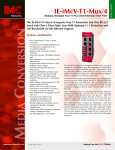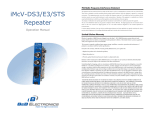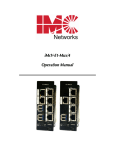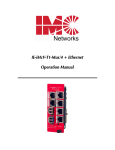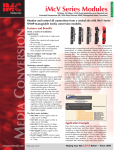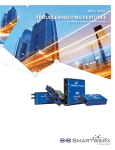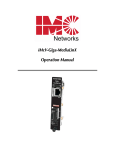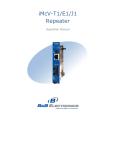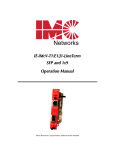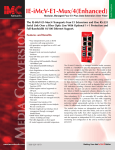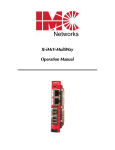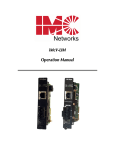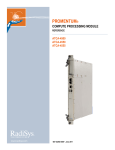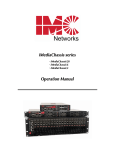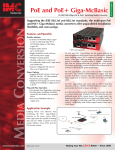Download IE-iMcV-E1-Mux/4 - B&B Electronics
Transcript
FCC Radio Frequency Interference Statement IE-iMcV-E1-Mux/4 This equipment has been tested and found to comply with the limits for a Class B computing device, pursuant to Part 15 of the FCC Rules. These limits are designed to provide reasonable protection against harmful interference when the equipment is operated in a commercial environment. This equipment generates uses and can radiate radio frequency energy and, if not installed and used in accordance with the instruction manual, may cause harmful interference to radio communications. Operation of this equipment in a residential area is likely to cause harmful interference in which the user will be required to correct the interference at his own expense. Operation Manual Any changes or modifications not expressly approved by the manufacturer could void the user’s authority to operate the equipment. The use of non-shielded I/O cables may not guarantee compliance with FCC RFI limits. This digital apparatus does not exceed the Class B limits for radio noise emission from digital apparatus set out in the Radio Interference Regulation of the Canadian Department of Communications. Le présent appareil numérique n’émet pas de bruits radioélectriques dépassant les limites applicables aux appareils numériques de classe B prescrites dans le Règlement sur le brouillage radioélectrique publié par le ministère des Communications du Canada. Limited Lifetime Warranty Effective for products of B&B Electronics shipped on or after May 1, 2013, B&B Electronics warrants that each such product shall be free from defects in material and workmanship for its lifetime. This limited lifetime warranty is applicable solely to the original user and is not transferable. This warranty is expressly conditioned upon proper storage, installation, connection, operation and maintenance of products in accordance with their written specifications. Pursuant to the warranty, within the warranty period, B&B Electronics, at its option will: 1. Replace the product with a functional equivalent; 2. Repair the product; or 3. Provide a partial refund of purchase price based on a depreciated value. Products of other manufacturers sold by B&B Electronics are not subject to any warranty or indemnity offered by B&B Electronics, but may be subject to the warranties of the other manufacturers. Notwithstanding the foregoing, under no circumstances shall B&B Electronics have any warranty obligations or any other liability for: (i) any defects resulting from wear and tear, accident, improper use by the buyer or use by any third party except in accordance with the written instructions or advice of the B&B Electronics or the manufacturer of the products, including without limitation surge and overvoltage conditions that exceed specified ratings, (ii) any products which have been adjusted, modified or repaired by any party other than B&B Electronics or (iii) any descriptions, illustrations, figures as to performance, drawings and particulars of weights and dimensions contained in the B&B Electronics’ catalogs, price lists, marketing materials or elsewhere since they are merely intended to represent a general idea of the products and do not form part of this price quote and do not constitute a warranty of any kind, whether express or implied, as to any of the B&B Electronics’ products. THE REPAIR OR REPLACEMENT OF THE DEFECTIVE ITEMS IN ACCORDANCE WITH THE EXPRESS WARRANTY SET FORTH ABOVE IS B&B ELECTRONIC’ SOLE OBLIGATION UNDER THIS WARRANTY. THE WARRANTY CONTAINED IN THIS SECTION SHALL EXTEND TO THE ORIGINAL USER ONLY, IS IN LIEU OF ANY AND ALL OTHER WARRANTIES, EXPRESS OR IMPLIED, AND ALL SUCH WARRANTIES AND INDEMNITIES ARE EXPRESSLY DISCLAIMED, INCLUDING WITHOUT LIMITATION (I) THE IMPLIED WARRANTIES OF FITNESS FOR A PARTICULAR PURPOSE AND OF MERCHANTABILITY AND (II) ANY WARRANTY THAT THE PRODUCTS ARE DO NOT INFRINGE OR VIOLATE THE INTELLECTUAL PROPERTY RIGHTS OF ANY THIRD PARTY. IN NO EVENT SHALL B&B ELECTRONICS BE LIABLE FOR LOSS OF BUSINESS, LOSS OF USE OR OF DATA INTERRUPTION OF BUSINESS, LOST PROFITS OR GOODWILL OR OTHER SPECIAL, INCIDENTAL, EXEMPLARY OR CONSEQUENTIAL DAMAGES. B&B ELECTRONIC SHALL DISREGARD AND NOT BE BOUND BY ANY REPRESENTATIONS, WARRANTIES OR INDEMNITIES MADE BY ANY OTHER PERSON, INCLUDING WITHOUT LIMITATION EMPLOYEES, DISTRIBUTORS, RESELLERS OR DEALERS OF B&B ELECTRONIC WHICH ARE INCONSISTENT WITH THE WARRANTY, SET FORTH ABOVE. ii Table of Contents FCC Radio Frequency Interference Statement ------------------------------------------------ ii Limited Lifetime Warranty------------------------------------------------------------------------- ii About the IE-iMcV-E1-Mux/4 --------------------------------------------------------------------- 1 Managed Modules --------------------------------------------------------------------------- 3 Port Interfaces --------------------------------------------------------------------------------- 3 Console Serial Port Connection ------------------------------------------------------------------- 4 LED Operation --------------------------------------------------------------------------------------- 6 10/100BaseT Connector -------------------------------------------------------------------- 6 E1 RJ-48 Connectors ------------------------------------------------------------------------- 7 Connector Pinout and DIP Switch Assignments ----------------------------------------------- 8 DIP Switch Assignments --------------------------------------------------------------------- 8 10/100BaseT Ethernet Mating Connector Pinout -------------------------------------- 9 E1 Port Mating Connector Pinout --------------------------------------------------------- 9 RS-232 Port Mating Connector Pinout ------------------------------------------------- 10 RS-232 Serial Console Port --------------------------------------------------------------- 10 Installation Instructions --------------------------------------------------------------------------- 11 Configuration Options --------------------------------------------------------------------------- 12 Ethernet Line Setup ------------------------------------------------------------------------ 12 Packet Size ----------------------------------------------------------------------------------- 12 Auto Negotiation --------------------------------------------------------------------------- 12 Forcing the Speed, Duplex Mode, and Flow Control ------------------------------- 12 FX LinkLoss and LFPT ---------------------------------------------------------------------- 12 FX LinkLoss (FXLL) -------------------------------------------------------------------------- 13 Link Fault Pass-Through (LFPT) ----------------------------------------------------------- 13 E1 Ports Setup ------------------------------------------------------------------------------- 13 Alarm Level ---------------------------------------------------------------------------------- 13 Last Gasp ------------------------------------------------------------------------------------- 13 Unit Service State--------------------------------------------------------------------------- 13 E1 Port Equipment ------------------------------------------------------------------------- 13 Loopback------------------------------------------------------------------------------------- 14 Console Screens ----------------------------------------------------------------------------------- 14 Login Screen ------------------------------------------------------------------------------------ 14 Main Menu ------------------------------------------------------------------------------------- 15 Menu Options------------------------------------------------------------------------------- 15 Unit Configuration Screen ------------------------------------------------------------------- 16 SFP Line Status Screen ------------------------------------------------------------------------ 17 Port Alarm Status Screen --------------------------------------------------------------------- 18 Ethernet Port Configuration Screen -------------------------------------------------------- 18 Ethernet Bandwidth Control ----------------------------------------------------------------- 19 Ethernet Port Status Screen ------------------------------------------------------------------ 19 E1 Port Configuration Screen ---------------------------------------------------------------- 20 iii E1 Port Equipment ------------------------------------------------------------------------- 21 Troubleshooting ----------------------------------------------------------------------------------- 22 Fiber Optic Port Verification ----------------------------------------------------------------- 23 E1 Port Verification ---------------------------------------------------------------------------- 24 Normal Operation ----------------------------------------------------------------------------- 25 Specifications -------------------------------------------------------------------------------------- 26 Standards/Compliance --------------------------------------------------------------------------- 26 Fiber Optic Cleaning Guidelines ------------------------------------------------------------ 27 Electrostatic Discharge Precautions ------------------------------------------------------------ 27 B&B Electronics Technical Support ------------------------------------------------------------ 28 Definition of Terms/Acronyms ------------------------------------------------------------------ 29 Certifications --------------------------------------------------------------------------------------- 31 iv The IE-iMcV-E1-Mux/4 offers the following features: About the IE-iMcV-E1-Mux/4 Overview The IE-iMcV-E1-Mux/4 is a media converter that transports four independent E1 lines over an existing standard 155Mbps-capable fiber optic line operating at an effective rate of 150Mbps. A second SFP port is available for a 1+1 protection mode. One serial link (RS-232) and one Ethernet (10/100BaseT) connection are also multiplexed onto the fiber link(s). Each of these communication channels is transported end-toend at full wire speed with very low latencies. The serial link can be used for extending an independent RS-232 interface to the remote Points of Presence (POP) location for use in managing or controlling other devices at the POP and supports any data rate up to 120K baud. In addition, each unit also supports an RS-232 console port for local configuration by technical support personnel. Both of these serial links are used for end-to-end system management, fault detection /isolation and system diagnostics. The remote serial offers serial only. The IE-iMcV-E1-Mux/4 provides fault indications on the E1 and fiber links resulting from real-time active faults. The equipment detects both E1 and fiber LOS events as well as degraded E1 or fiber lines. The unit will automatically forward AIS signaling to the remote unit after detecting an LOS (Loss Of Signal) condition on any incoming E1 line. Severe receive optical link failures will result in the automatic generation of AIS signaling onto the E1 lines connected to the unit receiving the corrupted optical signal. In addition, CV (Code Violation) errors are detected on all incoming E1 lines and BER calculations for the optical line are constantly being performed by circuitry within the unit's optical receiver. Error conditions are displayed on the unit’s front panel LED indicators and reported to system management software (if equipped) where more detailed error information can be displayed on the user’s GUI (SNMP). Systems equipped with 1+1 fiber redundancy can benefit from the enhanced reliability of a protected fiber link and the system’s ability to automatically switch to the “best” fiber line should one line become impaired or fail. This automatic switchover capability is designed to occur rapidly (<50 milliseconds), minimizing data loss and system down time. In addition, automatic switchover can be overridden; this allows the end-user to force the unit to receive on a specific optical line if desired for testing. • • • • • • • • • • • • • • Four E1 ports on RJ-48 connectors with surge protection One full bandwidth Ethernet 10/100BaseT port 1+1 protection switching via two SFP-based optical ports DDMI supported on SFP ports One end-to-end serial RS-232 port on an RJ-45 connector Local CLI management console port on a Mini Jack connector Remote management capability through iMediaChassis series AIS generation on signal loss on all E1 interfaces SNMP Alarm TRAP reporting in managed chassis MDI/MDIX automatic Ethernet port switching Last Gasp E1 port enable/disable Bandwidth Limiting for Ethernet Port AIS Detection The IE-iMcV-E1-Mux/4 module is a dual-wide iMcV module. Compatible chassis include the following: iMediaChassis series MediaChassis series IE-MediaChassis series Product Application The IE-iMcV-E1-Mux/4 delivers 4 E1 lines to a customer's site over a protected, dedicated fiber line. In addition, one serial RS-232 line and one 10/100BaseT Ethernet line can be carried at the same time. All circuits run at full line rates with no interaction. ISP Internet 10/100BaseT (1 Port) E1 (4 port) TDM Network PSTN Local Far End E1-Mux (Network) Dedicated Fiber Serial Port E1-Mux (Subscriber) Customer LAN E1 (4 Port) Customer PABX Host Console 1 10/100BaseT (1 Port) Console RS232 Remote Dedicated Fiber Protection (1+1) 2 Serial Port Remote Far End Console Console Serial Port Connection Managed Modules The IE-iMcV-E1-Mux/4 modules are installed as a Host/Remote pair. Host or Remote configuration is selected by an onboard DIP Switch setting. By default the DIP Switch setting is for a Host configuration. The Host/Remote pair can be remotely managed when the HOST is installed in an iMediaChassis with an SNMP Management Module. Port Interfaces A fully-configured IE-iMcV-E1-Mux/4 includes the following ports: Four E1 ports on RJ-48 connectors short haul One 10/100BaseT twisted pair Ethernet port One fiber SFP port (requires SFP/155-ED module for each port) One SFP port for optical 1+1 protection. One Mini Jack serial RS-232 serial console port One user serial RS-232 data port (RJ-45) 10/100BaseT Connector RS-232 Connector E1 RJ-48 Connectors SFP Ports Console The IE-iMcV-E1-Mux/4 is easily configured by using the serial console port connection at the HOST side, view only at the remote end, or through an SNMP management application such as iView². The IE-iMcV-E1-Mux/4 includes a console serial port. To establish a link between a module's console port and a local PC, connect the Mini Jack to DB9 adapter that is included with the B&B module. This serial console port connection provides access to the IE-iMcV-E1-Mux/4 module CLI configuration screens. Set the computer/terminal for VT-100 emulation, 38.4K baud, 8 data bits, 1 stop bit, no parity and no flow control. Under the VT-100 emulation, set the backspace key to send delete. 3 4 LED Operation iView² Management Software iView² is the B&B Electronics management software that features a GUI and gives network managers the ability to monitor and control manageable B&B Electronics products. iView² is available in several versions, including WebServer version 3.0, and can also function as a snap-in module for HP OpenView Network Node Manager and other third party SNMP Management software. iView2 supports the following platforms: Windows 2000 Windows XP Windows Vista Windows 7 Please see the SNMP Management Module for software configuration options. 10/100BaseT Connector RS-232 Connector E1 RJ-48 Connectors SFP Ports The IE-iMcV-E1-Mux/4 features diagnostic LEDs as explained below. 10/100BaseT Connector LNK: FDX: 5 OFF when port is not linked/connected Glows green when link is established Blinks green during data activity OFF when port is not connected or when running at halfduplex Glows yellow when port is running at full duplex Blinks yellow when collisions occur 6 E1 RJ-48 Connectors Connector Pinout and DIP Switch Assignments ALARM: OFF during normal operation Blinks red+green simultaneously when CV errors detected on the E1 line at far end of the optical line Glows red+green when loss of service (LOS) is detected, OR continuous bit errors are detected on the E1 line at far end of the optical line Blinks red when local CV errors detected on E1 line. Glows red when LOS detected on the local E1 line, OR when continuous errors are detected on the local E1 line Receiving AIS signal glows green if an error is detected down line that indicates a possible equipment problem upstream to this unit STAT: Glows green during normal operation Glows red+green when out-of-service or when the port is in a loopback or test state Glows red when the Host to Remote fiber link(s) is down or badly corrupted DIP Switch Assignments A single 10-position DIP Switch is located on the unit to set the configuration. The switch positions are defined as follows: SFP Ports ACT: LNK: Switch # Glows green when the SFP port is the active receive line. OFF when the SFP is not the receive line Glows red+green when the SFP port is manually forced to be the active receive line Glows green when there is a valid link Glows red when a loss of optical signal occur, LOF, or with continuous optical bit errors RAI: MSA: Off when no remote defects are detected Glows red+green when remote LOS or BER detected Glows green when no SFP alarms are detected Glows red+green when SFP alarms or defects are detected at remote end Glows red when SFP alarms or misconfigurations are detected locally, i.e., when the SFP is missing, or when SFP speed is not at 155Mbps 7 Function Settings Factory Default 1 Host/Remote OFF 2 3 4 5 6 7 8 9 10 Reserved Reserved Reserved Reserved Reserved Reserved Reserved Reserved Reserved OFF = Host, ON = Remote OFF OFF OFF OFF OFF OFF OFF OFF OFF OFF OFF OFF OFF OFF OFF OFF OFF OFF NOTE Switch #1 must be set to ON at the Remote location. Switches #2 through #10 are reserved for factory use only and must be OFF for proper operation. 8 10/100BaseT Ethernet Mating Connector Pinout RS-232 Port Mating Connector Pinout The following table lists the pin configuration for the standard RJ-45 Ethernet connector. The following table lists the pin configuration for the RS-232 port mating connector. Pin 1 2 3 4 5 6 7 8 Signal Transmit + Transmit Receive + None None Receive None None Pin 1 Pin 1 2 3 4 5 6 7 8 Signal None None None Signal Ground Receive Data (in to unit) Transmit Data (out of unit) None None Pin 1 This port provides an end-to-end RS-232 line that can support up to 120K Baud and is transparent to all RS-232 protocols. NOTE MDI/MDIX AutoCross function will automatically transpose the Transmit and Receive lines if required. E1 Port Mating Connector Pinout The following table lists the pin configuration for the standard RJ-48 E1 port mating connectors. Pin 1 2 3 4 5 6 7 8 Signal Receive 1 (Tip in to unit) Receive 2 (Ring in to unit) None Transmit 1 (Tip from unit) Transmit 2 (Ring from unit) None None None RS-232 Serial Console Port The following table lists the pin configuration for the RS-232 3-pin Mini Jack mating connector for the console serial port. Pin Tip Ring Sleeve DB9-F Pin# Signal Name Direction Transmit Receive Return Out of Unit In to Unit Return 2 3 5 Ring Sleeve Tip Pin 1 NOTE The pin configuration is consistent with a DTE interface. 9 10 Installation Instructions Configuration Options Each IE-iMcV-E1-Mux/4 module requires two adjacent slots in an iMediaChassis or MediaChassis. To install the module in a chassis, remove the blank faceplates covering the slots where the module is to be installed. Then slide the module into the chassis card guides until the module is seated securely in the slots. Secure the module to the chassis by tightening the captive screw. All IE-iMcV-E1-Mux/4 units are shipped from the factory configured as Host units. The IE-iMcV-E1-Mux/4 modules must be installed in pairs. For two IE-iMcV-E1Mux/4 units to properly operate together one unit needs to be configured as a Remote. Configuration as a Host or Remote is controlled via a DIP switch setting (S11). If installing in a managed chassis, set the card in the managed chassis as a HOST. The following sections describe the configurable features. Use the "default" command to restore the unit's default settings. This restores the card's default configuration and resets the default username and password. User: admin / Password: admin Ethernet Line Setup If the Ethernet port is not used, it can be set to disabled via a console session or via iView², to effectively block all traffic on this port. Packet Size Small Form-Factor Pluggable Ports (SFP) The Ethernet transport can accommodate packets up to 1916 bytes. The fiber link on the IE-iMcV-E1-Mux/4 module is supported through one SFP running at 155Mbps. The second SFP port can act as a redundant line. Many SFPs, including those from B&B Electronics, feature enhanced diagnostics capabilities DDMI (Data and Diagnostic Management Information). DDMI statistics provide realtime access to transceiver operating parameters such as voltage, temperature, laser bias current, and both transmitted and received optical power. DDMI information can be accessed in iView2. Auto Negotiation AutoCross Feature The 10/100BaseT Ethernet port on the IE-iMcV-E1-Mux/4 includes an AutoCross feature that automatically selects between a crossover workstation and a straightthrough connection depending on the connected device. The IE-iMcV-E1-Mux/4 ships from the factory with Auto Negotiation enabled on the Ethernet port. In this mode, the port negotiates for speed, duplex and flow control. Forcing the Speed, Duplex Mode, and Flow Control The Ethernet port on the IE-iMcV-E1-Mux/4 can be selectively advertised or manually forced for 10 Mbps or 100 Mbps operation at Half- or Full-Duplex (i.e., 10 Mbps Full-Duplex, 10 Mbps Half-Duplex, 100 Mbps Full-Duplex, etc.). Flow control can also be enabled on the Ethernet port when the connecting equipment supports this. These features can be enabled through iView² or the serial port. FX LinkLoss and LFPT During normal operation, link integrity pulses are transmitted by all point-to-point Ethernet devices. When an IE-iMcV-E1-Mux/4 receives valid link pulses, it knows that the device to which it is connected is up, and that the cable coming from that device is intact. The appropriate “LNK” (link) LED is lit to indicate this. However, these signals are not normally transmitted across a normal store and forward Ethernet bridge function. A failed Ethernet line on one end of the fiber link is not forwarded to the Ethernet port at the other end of the optical transport. A failed optical line is also not normally forwarded to the Ethernet port. The FX LinkLoss and LFPT functions are used to enable these features. For troubleshooting information utilizing the FX LinkLoss and LFPT features of the IEiMcV-E1-Mux/4 modules, refer to Troubleshooting at the end of this manual. Both the LinkLoss and LFPT features are set to "Disabled" by default. 11 12 FX LinkLoss (FXLL) Loopback FX LinkLoss is a link integrity monitoring feature that forwards fiber link faults to the RJ-45 DATA port to indicate that a fiber link fault has occurred. FX LinkLoss can be enabled in iView². Link Fault Pass-Through (LFPT) Link Fault Pass-Through (LFPT) is a troubleshooting feature that passes a link fault from the Ethernet port on one module through to the Ethernet port on the other module. LFPT can be enabled via iView² or through the console port. The link fault is passed through the media conversion and is observed at each end. It acts just as it would if the end devices were directly connected without a fiber link. E1 Ports Setup Alarm Level E1 lines are defined as LOST when no signal is received as defined by ITU G.775 specifications LOS, and are considered in error with a BER of 10^-6. If either of these conditions lasts for more than 2.5 seconds, an ALARM state is declared. This error condition must be absent for 10 seconds for the alarm state to clear. The starting and ending event of all alarm conditions will generate an SNMP TRAP when the unit is installed in a managed chassis and set to the IS state. During initial installation or normal maintenance, the end-user can place the unit in the OOS (OutOf-Service) state to inhibit unwanted SNMP TRAP alarms. Last Gasp Each E1 port can be tested in loopback mode by enabling either a Host loopback or Remote loopback test path. This capability allows the end-user to help troubleshoot and isolate system problems such as improper/broken line terminations, cables or malfunctioning equipment. With Host loopback, the E1 copper port, connected to the Host unit, is looped back to that port within the local unit. E1 data coming from the remote unit to that port over the optical link is also looped back to the remote unit at the same point within the local unit. With remote loopback, an E1 line connected to the Host unit is transported onto the optical link and looped back within the remote unit back onto the optical link without passing onto the copper E1 line of the remote unit. The remote’s incoming E1 copper line is also looped-back to the copper line within the remote unit. The default value for loopback is "none." Console Screens Configuration Using the Console Port The following section describes configuration using the console screens. The Remote module is only configured through the Host. Login Screen This feature alerts the end user if power to the device fails, and is permanently enabled. Since the IE-iMcV-E1-Mux/4 modules must be installed as a Host/Remote pair, the Host will report a power failure by sending an alarm trap to management. The Host will maintain the Last Gasp alarm state until it can verify that power has been restored. After running through an initial self test, the log-in screen is displayed (the diagnostic information displayed below is for illustration purposes only and may differ from the actual screen display): Unit Service State When selecting In-Service, Traps reporting is enabled. If Out-of-Service is selected, Traps reporting is disabled. A Trap is sent when the status is changed from Enabled/Disabled or Disabled/Enabled. E1 Port Equipment Within each E1 port setup, the state of the port can be set to equip or not-equipped. When set to not-equipped, the end user has the ability to perform maintenance on the line without impacting the other parts on the module. 13 The username is case sensitive with a maximum length of 16 characters. After a username is entered, the system prompts the end-user for a password. 14 Unit Configuration Screen Password is case sensitive with a maximum length of 16 characters. After the system validates the username and password, the Main Menu is displayed. Main Menu The unit configuration screen displays the names of the Host and Remote units as well as the service state, whether fiber protection is enabled and the SFP BER alarm level. In addition, the unit time can be set from this screen and the username and password can be set/reset. From the main menu, the end-user can view essential unit configuration data— including active alarms in order of importance—and a clock indicating when the displayed information was last refreshed. The screen displays the current status for items 1 through 8. For security reasons, the current username and password are not displayed. For items 1 through 8, enter the number of the menu item to be changed, and then enter the new value when prompted. The unit and port names can be assigned by the end-user and are used in SNMP associated TRAP alarm messages. Ethernet port Flow Control Menu Options 1 = Refer to the Unit Configuration Screen 2 = Refer to the Port Alarm Status screen 3 = Refer to the SFP Line Status screen; SFP DDMI alarms are also displayed 4 = Refer to the Ethernet Port Configuration screen 5 = Refer to the Ethernet Port Status screen 6 = Refer to the E1 Port Configuration screen 7 = Refer to the E1 Port Status screen 8 = Log out Flow Control can be enabled, to allow large amounts of data packets to pass without dropping them. The feather allows the end user to handle network congestion. NOTE On all configuration screens, the title is the same as the "option" selected from the previous screen. 15 16 SFP Line Status Screen Port Alarm Status Screen The SFP Line Status screen displays the status of the Host and Remote SFP links. The Port Alarm Status screen displays the status of the Host and Remote alarms on each of the unit's ports. This screen can be refreshed as needed to display current data. The detailed SFP information may be viewed by entering "1" for SFP A or "2" for SFP B. Displayed data includes the manufacturer name, code, part number and revision number. These values may not be modified. For SFP modules that support DDMI values for temperature, voltage, diode current and optical receive/transmit, levels can be obtained through SNMP Management Module. Ethernet Port Configuration Screen The screen displays the current values for items 1 through 9 for both the Host and Remote site. Enter the number of the menu item to change its configuration, and then enter the new value(s) when prompted. 17 18 Ethernet Bandwidth Control E1 Port Configuration Screen This screen displays the settings for the end user to configure bandwidth in 32Kbps increments up to 100Mbps. Use this screen to access the loopback and name details for each of the four E1 ports. Enter the number of the menu item to edit, and enter the new value(s) when prompted. Ethernet Port Status Screen E1 Port Status Screen This screen displays the current Ethernet port status for both the Host and Remote site. Use this screen to display the current status for each of the four E1 ports for the Host and Remote units. Enter the number of the menu item to edit, and enter the new value(s) when prompted. 19 20 E1 Port Equipment Troubleshooting Within each E1 port setup, the state of the port can be set to equip or not-equipped. When set to not-equipped, the end user has the ability to perform maintenance on the line without impacting the other parts on the module. 21 All IE-iMcV-E1-Mux/4 units are shipped configured as Host units via DIP Switch #1 = OFF. The Remote unit should be set to DIP Switch #1 = ON. Be sure to confirm that the IE-iMcV-E1-Mux/4 card is set correctly when used. The fiber transport is independent of all other ports and should be established first. If this is not possible, a physical fiber loopback can be used for fiber port verification. A fiber loopback will cause all connected ports to loop back their respected data. If the fiber is not connected, all E1 ports will send the all-ones, AIS signal. This can be physically looped back to verify E1 port operation. 22 Fiber Optic Port Verification E1 Port Verification As a troubleshooting aid, the fiber optic ports can be verified by placing a physical loopback optical line on the ports and verify the LED behavior as shown: The ACT LED will be configured to either the A or B fiber line as the active line. The RAI LED is RED/GREEN indicating that there is something wrong at the far end of the fiber line (in this case, the remote unit is missing). The ALARM LED is RED because the E1 port is not connected. The STAT LED is RED when there is no fiber link but turns GREEN when the fiber link is valid. By placing a physical loopback connection on the E1 port, a valid signal can be detected by each individual E1 port to verify its operation. Without the fiber looped, the ALARM LED for the looped E1 port will show RED/GREEN indicating there is a problem at the far end of the fiber transport (In this case the far end unit is missing) and the STAT LED is RED because the fiber is in LOS. With the fiber looped, the E1 port will only show a normal GREEN STAT LED. NOTE The E1 ports are all sending AIS. However, with the fiber looped, it is because of the LOS on the E1 port. Without the fiber looped, it is because of the LOS of the fiber port. WARNING An optical loopback will also loop back the Ethernet port. If the network cannot tolerate this, remove the Ethernet port connection before connecting the fiber loopback. 23 24 Normal Operation Specifications Under normal operation the following LED display is given: Power Consumption (Typical) 0.96A @ +5 VDC Operating Temperature -40°C to +158°F (-40°C to +70°C) GREEN LNK 10/100BaseT E1 10/100BaseT E1 Storage Temperature -40°F to +158°F (-40°C to +70°C) RS-232 E1 RS-232 E1 Humidity 5 to 95% (non-condensing); 0 to 10,000 ft. altitude E1 E1 E1 E1 Dimensions Dual Slot iMcV module GREEN STAT Standards/Compliance GREEN ACT, LNK, MSA IEEE 802.3x Flow Control IEEE 802.3i 10Base-T twisted pair IEEE 802.3u 100Base-TX twisted pair IEEE 802.3u 100Base-FX or SX fiber ITU G.775 GR-820-CORE GREEN LNK 10/100BaseT E1 10/100BaseT E1 RS-232 E1 RS-232 E1 E1 E1 E1 E1 GREEN STAT GREEN ACT, LNK, MSA 25 26 B&B Electronics Technical Support Fiber Optic Cleaning Guidelines Fiber Optic transmitters and receivers are extremely susceptible to contamination by particles of dirt or dust, which can obstruct the optic path and cause performance degradation. Good system performance requires clean optics and connector ferrules. 1. 2. Use fiber patch cords (or connectors, as appropriate) only from a reputable supplier; low-quality components can cause many hard-to-diagnose problems in an installation. Dust caps are installed at B&B Electronics to ensure factory-clean optical devices. These protective caps should not be removed until the moment of connecting the fiber cable to the device. Should it be necessary to disconnect the fiber device, reinstall the protective dust caps. 3. Store spare caps in a dust-free environment such as a sealed plastic bag or box so that when reinstalled they do not introduce any contamination to the optics. 4. If it is suspected that the optics have been contaminated, alternate between blasting with clean, dry, compressed air and flushing with methanol to remove particles of dirt. Tel: (800) 346-3119 (in the U.S. and Canada) Monday-Friday, 7:00am-7”00pm CST +353 91 792444 (Europe) Monday through Friday 8:00am - 5:00pm GMT Fax: (815) 433-5109 U.S. and Canada +353 91-79244S5 Europe E-Mail: [email protected] U.S. and Canada [email protected] Europe Web: www.bb-elec.com Electrostatic Discharge Precautions Electrostatic discharge (ESD) can cause damage to any product, add-in modules or stand alone units, containing electronic components. Always observe the following precautions when installing or handling these kinds of products 1. Do not remove unit from its protective packaging until ready to install. 2. Wear an ESD wrist grounding strap before handling any module or component. If the wrist strap is not available, maintain grounded contact with the system unit throughout any procedure requiring ESD protection. 3. Hold the units by the edges; do not touch the electronic components or gold connectors. 4. After removal, always place the boards on a grounded, static-free surface, ESD pad or in a proper ESD bag. Do not slide the modules or stand alone units over any surface. WARNING! Integrated circuits and fiber optic components are extremely susceptible to electrostatic discharge damage. Do not handle these components directly unless you are a qualified service technician and use tools and techniques that conform to accepted industry practices. 27 28 Definition of Terms/Acronyms The following are terms and phrases used within this manual (shown in italics), or which are found in documents associated with this equipment. 1+1 AIS The Term “1+1” refers to line protection where identical information is transmitted on two redundant lines. The Receiver chooses the “best” line to use based on the BER of the line. Alarm Indication Signal: Used in E1 signaling, the AIS is a predetermined bit stream (all ones) that is transmitted (forwarded) upon the loss of an incoming E1 signal or when the E1 signal is disrupted. AN Auto Negotiation: A signaling protocol used by an Ethernet PHY to determine the characteristics (speed, duplex mode) of its “link partner” and configure itself automatically BER Bit Error Rate: The percentage of bits with errors divided by the total number of bits that have been transmitted, received or processed over a one second time period. CLI Command Line Interface: An interface screen, often DOS-based, used for system management and diagnostics requiring the user to type commands rather than use a GUI. CV Code Violation: An anomaly of a decoded physical-layer signal stream resulting in coding (signaling) error(s). Noise bursts or intermittent connections on a link are the usual causes of code violations; an HDB3 coding error. DDMI Digital Diagnostic Monitor Interface: A defined serial interface and data format typically used to access SFP internal information FFL GUI Fiber Fault Loopback: When the fiber line fails, the Ethernet port that is being forwarded over the fiber line is forced out of LINK. Similar to the Fiber Alert function. Graphical User Interface: Software that provides a visual interface to enable an end-user to manage and monitor network devices. HDB3 High Density Bipolar 3 Coding: A physical-layer signal encoding scheme defined for E1 transmission which ensures sufficient signaling transitions for robust clock/data recovery. IS In-Service stat is the normal state of an active port with normal error reporting. 29 LED Light Emitting Diode: A small stack of lights to indicate link, duplex or other options. LFPT Link Fault Pass-Through: LFPT can be enabled via iView² or through the console port. LOF Loss Of Frame: An error condition where the receiver/decoder misses detection of the framing signal. LOS Loss Of Signal: An error condition where the receiving line interface unit does not detect a signal. MDI/MDIX Media-Dependent Interface/ Media-Dependent Interface Crossover. The ability of an Ethernet port to automatically detect and configure its cabling connections to accommodate crossover or non-crossover wiring, depending on its link partner and cabling. MIB Management Information Base: A database of objects that can be monitored by a network management system. Both SNMP and RMON use standardized MIB formats that allow any SNMP and RMON tools to monitor any device defined by a MIB. MSA Multi-Source Agreement (SFP): The standard an SFP must meet to be compatible in network devices. OOS Out-Of-Service, OOS is used by the CRAFT personnel to turn OFF the alarm reporting so they can service the line without causing alarm TRAPS to be sent to the NOC Center. The LEDs display a line status but do not report any line related alarms back to the NOC. A card removal or insertion is still reported, but a PORT up/down or changes to its configuration are not. POP Point(s) Of Presence: The demarcation point where carrier owned equipment is located at the customer site. RAI Remote Alarm Indication: Status information received from the line indicating there is an alarm condition at the far end of the transport. SFP Small Form-Factor Pluggable: An industry standard optical pluggable module. SNMP Simple Network Management Protocol: A set of protocols for managing complex networks over a standards-based IP network. 30 Certifications CE: The products described herein comply with the Council Directive on Electromagnetic Compatibility (2004/108/EC). International Headquarters European Directive 2002/96/EC (WEEE) requires that any equipment that bears this symbol on product or packaging must not be disposed of with unsorted municipal waste. This symbol indicates that the equipment should be disposed of separately from regular household waste. It is the consumer’s responsibility to dispose of this and all equipment so marked through designated collection facilities appointed by government or local authorities. Following these steps through proper disposal and recycling will help prevent potential negative consequences to the environment and human health. For more detailed information about proper disposal, please contact local authorities, waste disposal services, or the point of purchase for this equipment. B&B Electronics 707 Dayton Road Ottawa, IL 61350 USA Phone (815) 433-5100 — General Fax (815) 433-5105 Email: [email protected] Website: www.bb-elec.com European Headquarters B&B Electronics Westlink Commercial Park Oranmore, Co. Galway, Ireland Phone +353 91-792444 — Fax +353 91-79244S5 Email: [email protected] Website: www.bb-elec.com © 2013 B&B Electronics. All rights reserved. The information in this document is subject to change without notice. B&B Electronics assumes no responsibility for any errors that may appear in this document. IE-iMcV-E1-Mux/4 is a trademark of B&B Electronics. Other brands or product names may be trademarks and are the property of their respective companies. Document Number 57-80400-03 A0 31 September 2013


















